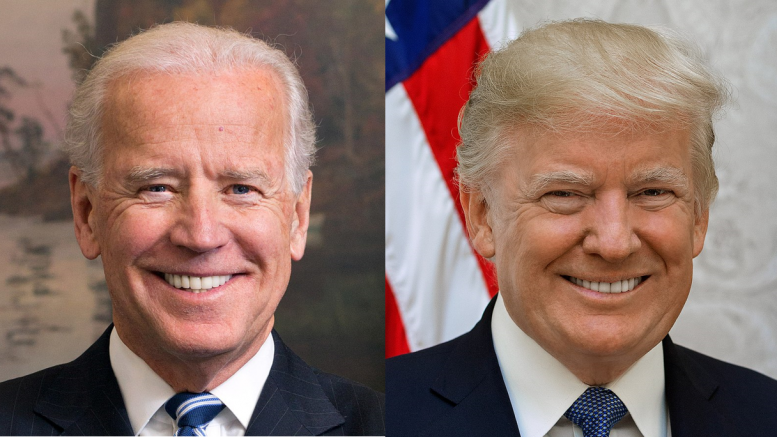- Arizona: Biden 49% – Trump 43% Kelly 50% – McSally 43%
- 10/5: Biden 49% – Trump 41% | Kelly 50% – McSally 39%
- 9/18: Biden 49% – Trump 40% | Kelly 50% – McSally 42%
- Florida: Biden 47% – Trump 44%
- 10/5: Biden 47% – Trump 42%
- Pennsylvania: Biden 49% – Trump 43%
- 10/3: Biden 49% – Trump 42%
- 9/28: Biden 49% – Trump 40%
- Wisconsin: Biden 52% – Trump 41%
- 10/12: Biden 51% – Trump 41%
- 9/12: Biden 48% – Trump 43%
Loudonville, NY. Former Vice President Joe Biden leads President Donald Trump by 11 points in Wisconsin, six points in both Arizona and Pennsylvania, and three points in Florida – all states that Trump carried in 2016 – in the last four New York Times/Siena College polls of likely voters in the 2020 cycle.
“Wisconsin appears out of reach for Trump and likely to return to the Democratic side of the ledger. Arizona and Pennsylvania each give Biden a solid but not solidified six-point lead. And Florida is, well, Florida. Leaning to Biden by three points, the Sunshine state is once again headed to a photo finish,” said Don Levy, Director of the Siena College Research Institute.


“In his bid to become the first Democratic presidential candidate to carry Arizona since 1996, Biden is holding a six-point lead over Trump, down slightly from eight points a month ago, heading into the final days of the campaign, even as three-quarters of Arizonians have already voted,” said Don Levy, Director of the Siena College Research Institute.
“Biden has a 54-38 percent lead with those who have already voted – which includes 85 percent of Democrats and 70 percent of Republicans – while Trump holds a 58-31 percent lead among the nearly one-quarter still planning to vote – including 30 percent of Republicans, 14 percent of Democrats and 24 percent of independents,” Levy said. “Trump leads by eight points with men, and Biden leads by 18 points with women. White voters continue to back Trump by seven points, not enough to offset Biden’s 40-point lead with Latino voters, expected to comprise about one-fifth of the electorate.
“Trump carried Arizona by about three points in 2016. He has a lot of ground to make up but at the moment it looks as if Biden has a good chance to shift the Grand Canyon State’s 11 Electoral College votes into the Democratic column,” Levy said.
“In the race for U.S. Senate, Republican incumbent Martha McSally has chipped into Democratic challenger Mark Kelly’s lead, cutting her deficit to seven points, down from 11 points last month,” Levy said. “Kelly continues to enjoy near-universal support from Democrats and a better than 20-point lead with independent voters.
“Like Biden, Kelly trails narrowly with men but leads with women by 19 points. Like Trump, McSally has an uphill climb to close and reverse the deficit she’s facing trying to win re-election,” Levy said.

“In what appears to be part of a now routine quadrennial occurrence, Florida looks like it will once again be about as tight as size 12 feet in size 10 shoes,” Levy said. “Biden has a narrow three-point edge, down from five points a month ago, owing to his continuing lead among independents, now 10 points.
“Biden has a nine-point lead with women, while Trump edges Biden with men by two points,” Levy said. “There has been little movement in two key Florida demographic groups. Voters 65 and older tilt toward Biden by two points – now and a month ago. And Latinos favor Biden by 22 points, little changed from his 24-point lead last month,” Levy said.
“Among the two-thirds of Floridians who’ve voted, they favor Biden 55-39 percent. While 82 percent of Democrats have voted already, only 63 percent of Republicans have. Among those yet to vote, Trump leads 56-30 percent,” Levy said. “In 2000, the late Tim Russert famously said about that election, ‘Florida, Florida, Florida.’ Well, we might just be saying the same thing come Tuesday night. The good news is Florida is quick in reporting both its early and election day results.”

“Despite everything in the last month, all the money and campaigning, virtually nothing has changed in the race between Trump and Biden in Pennsylvania,” Levy said. “Both candidates have the support of nine in ten voters from their party and Biden continues to lead among independents, currently by 12 points. Men tilt to Trump by three points and women favor Biden by 14 points.”
“Biden continues to have overwhelming, 71-19 percent, support from non-white voters and white voters are closely divided. Whites with a college degree favor Biden by 22 points, while those without a degree favor Trump by 17 points,” Levy said. “Biden has a 51-point lead with city voters, a 14-point lead with key suburban voters, and Trump has a two-to-one, 61-32 percent lead in the rural areas of the Keystone State.
“Among the one-third of Pennsylvanians – including more than half of Democrats – who’ve already voted, they favor Biden 79-16 percent. But among the two-thirds yet to vote – including 85 percent of Republicans – Trump has a 57-34 percent lead,” Levy said. “In a state with a big reward of 20 Electoral College votes that Trump carried by less than one point in 2016, Biden seems to have the advantage.

“Biden continues to have the support of 97 percent of Democrats while Trump brought home a few stragglers and now has the support of 94 percent of Republicans. Independents, however, continue to move away from Trump and to Biden, providing Biden with an 11-point lead in Wisconsin heading into election day. Biden led among independents by 14 points in September, 18 points three weeks ago, and now leads Trump among independents two-to-one, 59-29 percent,” Levy said.
“Trump previously held a seven-point lead with men and now Biden edges him there, 47-45 percent. Biden’s lead with women fell a few points but still stands at 19 points,” Levy said. “While Biden runs close with Trump among whites without a college degree, trailing by two points, he holds a commanding 62-35 percent lead with college educated white voters and a 67-21 percent lead with non-white voters.
“Among the 58 percent of voters who’ve already cast their ballot – including three-quarters of Democrats and half that number of Republicans – Biden holds a commanding 68-26 percent lead. However, Trump holds a nearly as large 61-31 percent lead among those who have not yet voted,” Levy said. “Trump won the Badger State by less than a point four years ago but it appears that this year, Wisconsin is swinging very heavily back in the direction of the Democrats.”
This New York Times/Siena College survey of Arizona was conducted October 26-30, 2020 by telephone calls in English and Spanish to 1,252 likely voters, with a margin of error of +/- 3.0 percentage points.
This New York Times/Siena College survey of Florida was conducted October 27-31, 2020 by telephone calls in English and Spanish to 1,451 likely voters, with a margin of error of +/- 3.2 percentage points.
This New York Times/Siena College survey of Pennsylvania was conducted October 26-31, 2020 by telephone calls in English to 1,862 likely voters, with a margin of error of +/- 2.4 percentage points.
This New York Times/Siena College survey of Wisconsin was conducted October 26-30, 2020 by telephone calls in English to 1,253 likely voters, with a margin of error of +/- 3.2 percentage points.
For all four polls, calls were made to a stratified weighted sample of voters from the L-2 Voter list via both land and cell phones. The data was weighted by party, age, race/ethnicity, education, region, gender and voter likelihood, a computed score that combines voter history, stated voter likelihood and modeled turnout by respondent. Polling support for this project provided by Institute for Policy and Opinion Research at Roanoke College, M. Davis and Co., Reconnaissance Market Research, and The Public Opinion Research Lab at the University of North Florida. The Siena College Research Institute, directed by Donald Levy, Ph.D., conducts political, economic, social, and cultural research. SCRI, an independent, non-partisan research institute, subscribes to the American Association of Public Opinion Research Code of Professional Ethics and Practices. For more information, please call Don Levy at 518-944-0482. Survey cross-tabulations and frequencies can be found at: www.Siena.edu/SCRI/SNY. For additional methodological information, click here.





